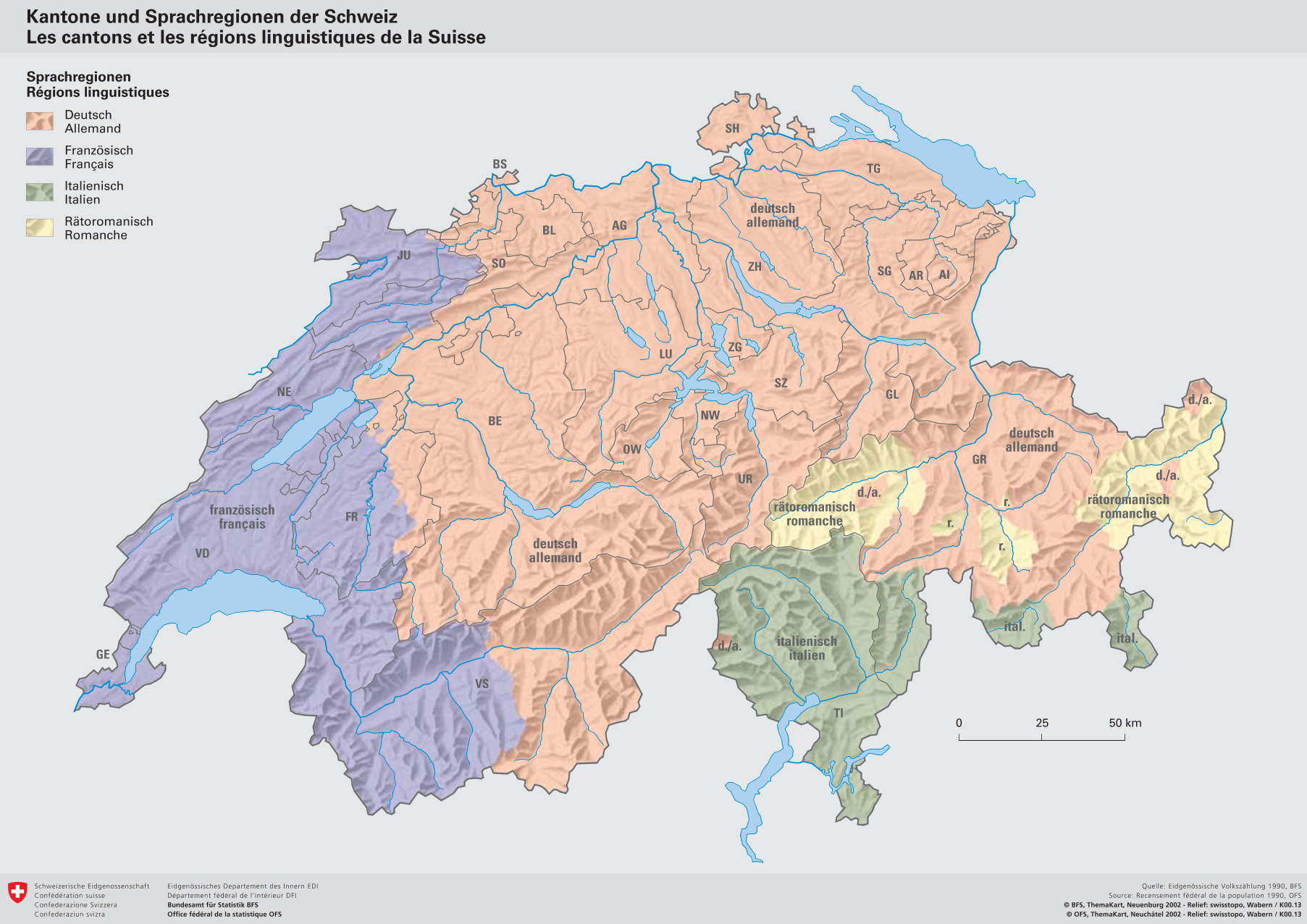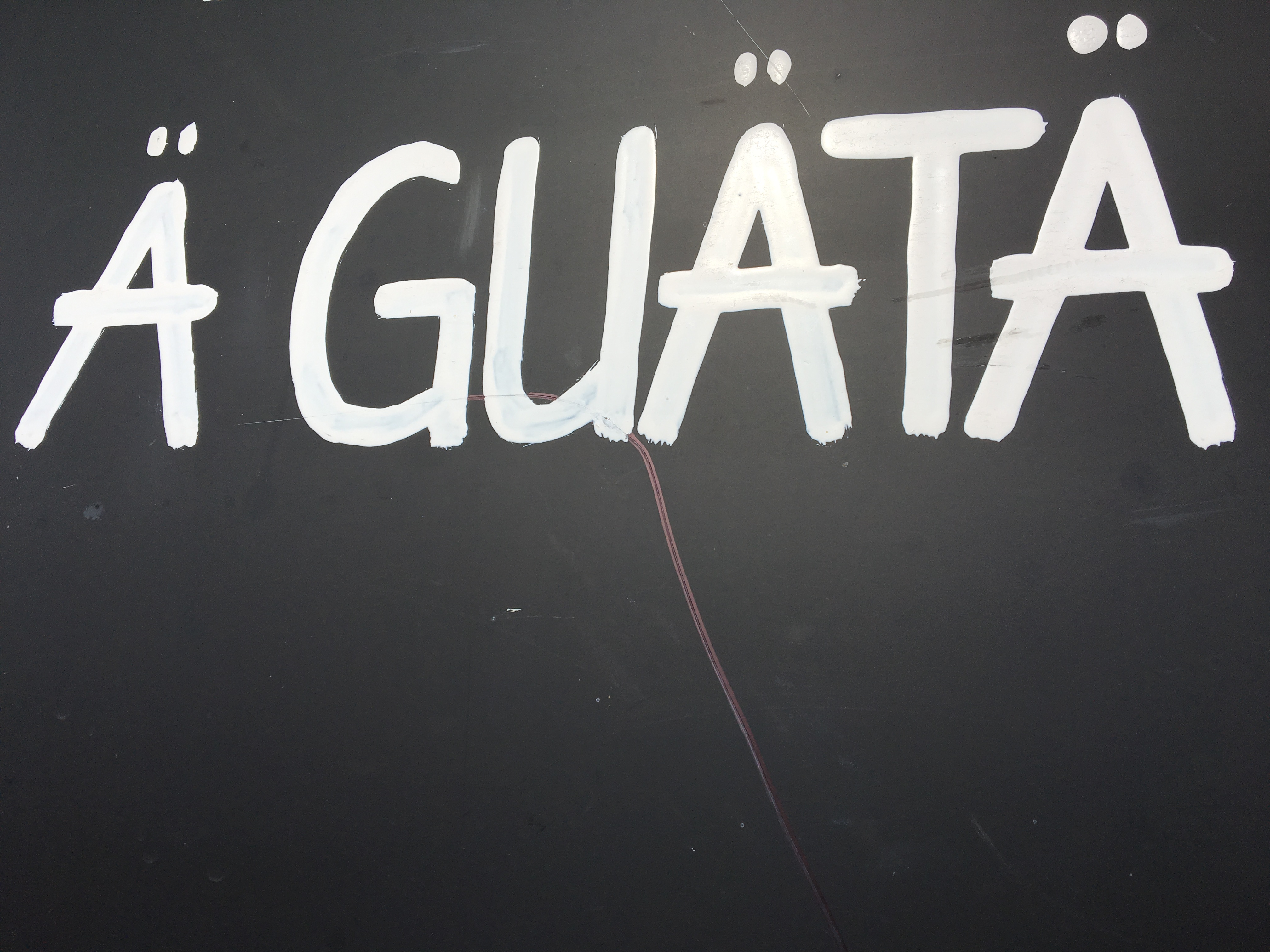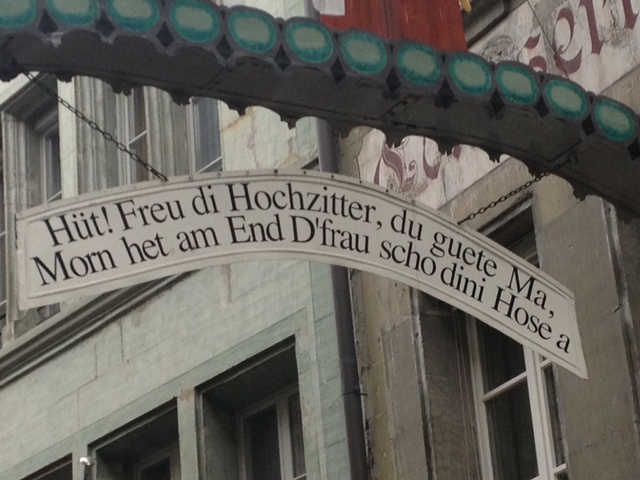Swiss German Dialects: A Real Challenge for German Learners
 Understanding Swiss German dialects is a real challenge for German learners. But they are not alone: Even German natives often have great difficulties with some Swiss German dialects.
Understanding Swiss German dialects is a real challenge for German learners. But they are not alone: Even German natives often have great difficulties with some Swiss German dialects.
When traveling in Switzerland, hearing different languages spoken is just part of the experience. Sitting in a café, riding on a tram, going by train, standing in a chairlift line, walking in the countryside - you're bound to hear people speak Swiss German with each other.
Earlier we wrote about "Grüezi and Other Swiss German Expressions, which includes a link to the popular 60s Swiss German "ear-worm": “Ja grüezi wohl Frau Stirnimaa”.
Swiss German
As you can also see on the map above, the (Swiss) German Cantons occupy the largest region of Switzerland.
But why are Swiss German dialects such a big challenge for German learners? There are a few reasons.
When we say “Swiss German”, we are not referring to a unified language. As they grow up, Swiss Germans learn to speak different versions of the Alemannic German dialect, depending on the region in Switzerland they live in. Only when they start kindergarten or school are they exposed to "standard" and written German. One could therefore argue that all Swiss Germans grow up bilingually.
Any of the Swiss German dialects differ from standard High German in sound (phonology), grammar and vocabulary. Because of the different sound systems, people from northern Germany do not easily understand Swiss German.
 There is also no standard written Swiss German. In writing, Swiss Germans use their dialect mostly just for some informal communication, sometimes in emails, text messages, on social media, occasionally in personal letters etc. The words are then written phonetically, just the way they are said.
There is also no standard written Swiss German. In writing, Swiss Germans use their dialect mostly just for some informal communication, sometimes in emails, text messages, on social media, occasionally in personal letters etc. The words are then written phonetically, just the way they are said.
The sign left we saw at a restaurant wishes "Guten Appetit" (Enjoy your meal). People also say it to each other before a meal.
In all official and business communication, standard German ("Schriftdeutsch" i.e. written German) is used.
But Swiss Germans from different regions in Switzerland (and some Austrians, e.g. from Vorarlberg, who also speak an Alemannic dialect) do mostly understand each other, maybe with the exception of some remote mountain dialects.
Four Swiss German Dialects
We've chosen 4 Swiss German dialects to look at: Baseldytsch (Basel German), Züritüütsch (Zurich German), Bärndütsch (Bern German), Wallisertiitsch (Valais German).
To simplify: Swiss German dialects range from Low Alemannic, to High Alemannic, and to Highest Alemannic, with Low, High, and Highest referring to the geography of Switzerland.
Low Alemannic is spoken in the northernmost parts of Switzerland, which include the city of Basel.
High Alemannic is spoken spoken on the Central Plateau, an often hilly stretch of land that extends between the Jura mountains (south of Basel) and the Alps. Both cities of Bern and Zurich are located on the Swiss Plateau.
Highest Alemannic is spoken in the alpine regions of Switzerland, which include the Canton of Valais.
A Sample
Remember, there is no standardized spelling of Swiss dialects. In the examples below, you'll hear how this typical conversational exchange sounds in the four different regions. There are some differences in the sounds, but listen especially to the music (intonation) of each phrase.
(See the German translation in parenthesis. Please note: The spelling of the dialect reflects what we as German speakers hear. If you have other suggestions, please write us.)
"How are you?" (Wie geht es Ihnen?)
"I am fine, thanks. And how are you?" (Gut, danke. Und wie geht es Ihnen?)
Basel(Stadt) dytsch - Basel German
Wie gahts ihne?
Danke guet. En wie gahts ihne?
Züritüütsch - Zurich German
Wie gahts inne?
Tancke guat. En wie gahts inne?
Bärndütsch - Bern German
Wie geits aich?
Danke gut. An wie geits aich?
Wallisertiitsch - Valais German
Wie gaits eiwe?
Danke güet. En wie gaits eiwe?
Worried about getting the sound right? If you're greeted when you enter a shop, for example with the universal Swiss ”Grüezi“, it may be best for you to just echo the greeting back.
 Our visits to Switzerland have been mostly to the bilingual city Fribourg, which straddles a language border between French and the Swiss German. To find out more about bilingualism in Fribourg, click on the article by Antilia Wyss HERE.
Our visits to Switzerland have been mostly to the bilingual city Fribourg, which straddles a language border between French and the Swiss German. To find out more about bilingualism in Fribourg, click on the article by Antilia Wyss HERE.
Can you decipher this sign in the "Hochzeitergasse" (Bridal Couple Lane) in Fribourg? (A hint: It is not politically correct...!)
We've also gone many times to the Berner Oberland to ski. Read about our Bärndütsch language lessons in Gstaad.
How Many Swiss German Dialects Are There Really?
Hard to count. One YouTube video presents 23 different Swiss German dialects. There is also an iOS app that's called Diäläkt App, where Swiss Germans can record local words and find out what region(s) they come from. You can listen to various examples. One could also say that each village has its own dialect that people continue to use.
Why Are There So Many Swiss German Dialects?
A brief summary helps to understand why: "The need for a standardized German written language came up in early 15th century at the time of the Reformation. There were practical reasons behind it: The Bible, later also newspapers, works of literature, political declarations, etc. should be read and understood by all. It would have been impossible to translate these into the various dialects.
Most Germans accepted the written language also as the basis of its spoken form. However, Swiss people did not. To this day, they have continued to use their dialects in private and business conversations, even in schools and universities."
(The above is a translation of a paragraph from this Switzerlandical blog post.)
To listen to four different dialects: Basel, Zurich, St. Gallen (a city in the east of Switzerland) and Bern, click HERE.
If you're a tennis lover, you'll recognize Roger Federer in the interview on the video clip: He speaks the Basel city dialect.
German in Switzerland by Numbers
German is the sole official language in 17 (out of 26) Swiss cantons; French and German are co-official in 3 cantons. In 2020, 62.3% of the population of Switzerland were native speakers of German (either Swiss German or Standard German at home), 22.8% French (mostly Swiss French); 8% Italian; and 0.5% Romansh. From Wikipedia: Languages of Switzerland.
Lessons and Courses
If you're moving to the Swiss German part of Switzerland, you may want to take lessons and learn a particular dialect. You can search for YouTube lessons. There are also a couple of iOS apps:
- "Grüezi Switzerland" - a travel app with many practical phrases and sentences in 19 different Swiss German dialects;
- "Swiss German: with Kathrin Erni" - with live lessons videos and flash cards;
- "Swiss Words by Philipp Egli" - a vocabulary app with audio.
All others might enjoy finding out a little more about the dialects, and try out a few of the expressions.
Disclosure: The audio for the dialect versions of of the phrases "Wie geht es Ihnen?" and "Gut, danke. Und wie geht es Ihnen?" are taken from the iOS travel app "Grüezi Switzerland". On the app you can find the audio of a large number of sentences and phrases in 19 different Swiss dialects. We have no relationship with the "Grüezi Switzerland" app, or any of the other apps mentioned above.
Bio: Ulrike & Peter Rettig are co-founders of Gamesforlanguage.com. They are lifelong language learners, growing up in several European countries before moving to Canada and the United States. You can follow them on Facebook, Twitter, and Instagram.
